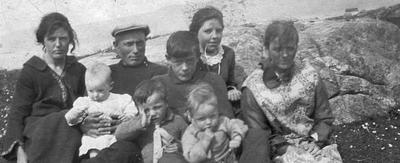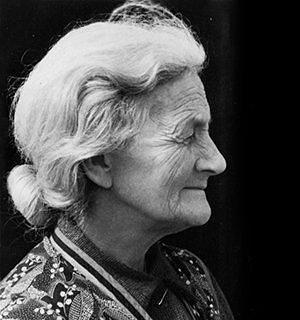
Families re-united by the Sound of a Voice
Flòraidh Forrest, project director for Tobar an Dualchais, discusses what she has learnt from archive recordings about her own family and, with it, the social history of South Uist, Eriskay and Barra.
Through my work, I’ve seen people moved to tears after hearing a loved one’s voice decades after their death.
In one astonishing example, that happened just after the launch of Tobar an Dualchais, a man whose father had died in the Second World War before he was born was able to hear his father’s voice for the first time.
For most of us, we can only imagine what that must have been like: strangely recognisable phrases and subtle mannerisms or turns of phrase, along with deeper thoughts of how things might have been different…
Whatever the case, we can be sure that for those who are able to reconnect or gain greater insight through the recordings of friends and family members long after they have passed is truly extraordinary and deeply personal.
My mother, Isabel (Bellag) MacKenzie, had one of these experiences when she attended an event hosted by TAD in Lochboisdale in 2008.
Although she had an inkling that members of her family were recorded by folklorists it still came as a shock when she heard a recording of her mother, Flora MacInnes, Flòraidh Raghnaill – my grandmother – singing ‘Òran Èirisgeigh’ (TAD ID:28227).
She of course immediately recognised her voice, although it had been some 30 years since her mother’s death.
I never got to meet my grandmother. She died on Good Friday in 1978 in the Sacred Heart Hospital in Daliburgh, South Uist. I was born six months later in the same hospital.
I’ve always felt a special connection to her because I was named after her, although this almost didn’t happen.
My mother (in keeping with a current trend it would seem) thought she would name me ‘Fiona’. However, when our doctor, the highly regarded Dr Alasdair MacLean (brother of Somhairle), asked what I was to be called and was told, he replied abruptly and conclusively declared that I was instead to be named after my grandmother. And that was that!
It is a joy for me to be able to listen to my grandmother’s recordings. Her singing voice is quite similar to my mother’s, and through listening, I get a sense of the person she was.
In one recording with John Lorne Campbell, after he announces her name (as Mrs Norman MacInnes!) in his full, confident, upper-class accent, she remarks to everyone in the room “Chluinneadh tu siud ann an Glaschu no Ameireagaidh!” (You’d hear that in Glasgow or America!) (TAD ID: 33940).
That mischievous sense of humour is definitely a trait which has been passed down. It’s also clear she was used to calling the shots and was the matriarch of the family and, notwithstanding the exceptional overruling from Dr MacLean with my mother, it might also be reasonably claimed that female dominance is another heritable trait of Clann Tharmaid!
Flòraidh was certainly hardy, like many women in those days.
She gave birth to 11 children and my mother was the youngest of the ten that survived. She described her eleventh child as “gille mòr snog” (a beautiful big boy). He was stillborn, and very little mention was made of him after his birth.
His body was kept in a little white coffin in what others would call the sitting room today (‘uachdar an taighe’) until he was carried out by my grandfather who, with the other children in the family, took him to the cemetery in Baile, Eriskay.
Already grateful for the opportunity to hear these recordings of my grandmother, I was truly amazed when I found recordings of her mother – my great grandmother, Mary Johnston.
Although attempts had been made by family members over the years to locate these recordings of her, no one had succeeded until I happened upon them quite by accident.
She was recorded in 1960, shortly before she died, by Father Angus John MacQueen who was collaborating with John Lorne Campbell at the time and helping to build what now constitutes the ‘Canna Collection’.
Mary Johnston (neé MacNeil) or ‘a Nì’ as she was known to her family, was born in Barra in 1871 and was the daughter of Michael MacNeil of Castlebay and Anne Steele of Boisdale, South Uist.

At the age of around four her mother passed away and she was taken to Uist to live with her auntie, whilst her father worked at sea.
As she tells us: “Nuair a dh’ eug mo mhàthair, dh’ fhalbh m’ athair air feadh an t-saoghail a’ seòladh” (When my mother died, my father travelled the world sailing) (TAD ID: 108359).
She tells how after her grandfather’s death her father was given an ultimatum: return home to the family croft on Berneray (Barra Head) or it would be handed over to someone else.
Michael returned, promptly re-married, and Nì was sent back to live with him and her new stepmother.
In the recording she talks about life on Berneray and of others who lived there, including her uncle Ailean who carted oil from the quay to the lighthouse by horse, and of other men in her family whose entrepreneurial streak resulted in the establishment of the first curing station in Lerwick. (TAD ID: 108359).
What isn’t mentioned in the recordings is that she was sent to the recently founded Orphanage for Roman Catholic Children in Bute where she trained as a cook.
On her return to Barra she met Ronald Johnston from Eriskay who was working in a shop in Castlebay and soon after they eloped to Glasgow. The fact that they were of a similar age to one another was considered undesirable at the time; more conventionally, women tended to marry men a fair bit older than them.
They had eight children together; four girls and four boys – two of whom were killed in the Great War.
The German aristocrat and photographer Werner Kissling took two marvellous photos of Nì during his famous filming trip to Eriskay in 1934. The photos somehow manage to at once capture conflicting expressions of happiness, sadness, restlessness and contentment. A neat and handsome lady, she nevertheless seems considerably older than the 63 years she had already lived when Kissling visited.
She is remembered as a kind woman who spoke often of life in Barra and the Barra Head islands, though she never set foot on any of them again after her marriage.
It means a lot to me that I can listen to recordings of these two women on Tobar an Dualchais. Hearing their voices and listening to them sing songs and give descriptions of the places they lived gives me a stronger sense of who I am.
I’m especially fortunate to have two female members from my family on TAD, where men outnumber women by almost two-to-one. It is sad to reflect that while some of the resource’s greatest contributors, including Annie Arnott, Annie Johnston, Betsy Whyte, Catherine Dix, Nan MacKinnon and Jeannie Robertson are women, women’s voices are so proportionately under-represented. No one is to blame for this; it is just a reflection of the time in history when so much of this material was collected.
Looking at the present and to the future, I can see that there is a precious opportunity to speak with my own mother about her life, about themes more related to women, and to motherhood in particular.
She herself gave birth to seven children in the 1970s whilst working part-time as a physiotherapist. She was straddling a very traditional world while also trying meet the growing, and often conflicting, expectations of a modern professional woman.
She, like so many other women of her generation, has an important story to tell and important insights to give.